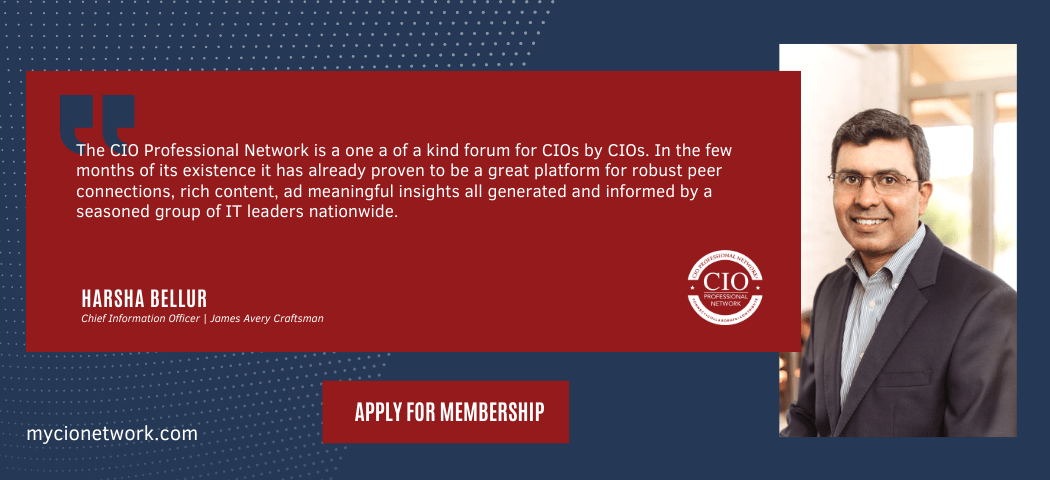This is an excellent time to be a Chief Information Officer. The ubiquity and importance of technology across every industry guarantees a need for IT leadership, and – perhaps more importantly – IT departments and business leaders are cooperating at higher levels than in years past. Beth Stackpole, writing for CIO.com, reported increased collaboration in the publication’s annual State of the CIO survey. Summarizing the finds of the survey, she writes, “While some disconnect remains, IT and LOB have turned the corner and are working far more collaboratively than in the past.”
The idea of a CIO filling the role of business partner is nothing new, but the steady rise of work environments that encourage (rather than discourage) this relationship allows IT professionals and business executives everywhere to do their jobs more efficiently across a variety of industries. Since CIOs work in companies across every line of work, this collaboration looks much different in the field of hospitality than it might for an insurance company. The high-level strategy for success (cooperation) may be the same everywhere, but the specific ways that this strategy plays out can vary greatly.
At the National CIO Review, we’ve seen many different leadership examples through our extensive interviews of technology executives. Through all these conversations, one singular idea stands out: the diversity of approaches and strategies shows that while the high-level description of a CIO may be simple, the actual execution of the position requires tailored approaches and elite leadership skills. Taken together, the collective responses in our interviews have much to say about the role of a modern CIO, from high-level planning to specific results.
One challenge CIOs face is keeping business operations concurrent with new technologies. Mike Nettles, CIDO of Papa John’s, spoke to these issues in an earlier interview with us. Smartphone ordering has already dramatically changed the experience of ordering a pizza in years past, but Nettles also brought up even newer changes. He mentioned the Internet of things, specifically voice-activated devices like the Amazon Echo or Google Home. “Voice ordering may one day replace any and all screens,” he told us, “which would also change payment and authentication requirements as well.” For Nettles, the key to adapting to technological change is to think ahead and prepare, rather than waiting to react to new developments. It’s difficult to say with certainty what ordering a pizza will look like in 10 years, but it’s a safe bet that Papa John’s will be ready.
Jodi Eddy, CIO of Boston Scientific, faces a similar challenge of rapidly-changing technology, albeit with much different products in the digital health space. “Advances in predictive analytics, coupled with sensor data, will have broad implications for end-users of medical devices,” she told us earlier this year. For Eddy, the effects of new technology have important consequences. “An implanted pacemaker, for example, records sounds, rhythm, and blood pressure around the clock. With expanded data capabilities, one will be able to make more informed patient decisions.” For Boston Scientific, staying abreast of technological changes will continue to be critically important going forward.
Eddy and Nettles both approach their roles from a business-first perspective. These two executives are experts at their jobs, and both understand how to employ their expertise to ensure that their companies use technology efficiently and effectively. Their specific circumstances vary greatly because of their vastly different fields, but it’s also clear that Eddy and Nettles share this similar mindset. As other executives we spoke to demonstrate, this approach is common for the best technology leaders.
An emphasis on customer service forms a key part of many business strategies. Dave Finnegan, the Chief Experience Officer for Orvis, discussed how his company approaches this issue when he spoke with us in March. He said, “On the technology side, we’ve stayed focused on investing in customer experiences. We’ve done some great things in re-platforming in-store point of sale and adding new functions to the store and online ordering process, including mobile.” For Finnegan, the rise of mobile ordering means an opportunity to enhance one of his company’s best assets – a single-minded focus on enriching customer experiences – for present and future growth.
Sarah Naqvi, CIO for HMSHost, also places a premium on customer support and experience. “I see us developing more interactions with customers and with our retail, airport, and airline business,” she told us. “We will continue to collaborate with them for common solutions that keep the customers in mind and improving their experiences.” Naqvi also mentioned the importance of mobile applications and payments, displaying a deep understanding of how new technology will continue reshape the hospitality industry. Although Naqvi’s customers undergo much different experiences than those visiting Finnegan’s stores, each leader leverages his or her role to ensure company success at the point of service.
Another key business strategy is continued support of important, lasting goals under changing circumstances. Dennis Yang, CIO for the MPAA, spoke at length on how he helps his organization approach its central objectives. “Regardless of market and technological changes, the MPAA will continue to serve as the voice and advocate of creators and storytellers, working to advance the global creative economy,” he told us. The MPAA’s goals fall into a completely different industry than the companies of most CIOs we spoke with, and Yang works to use his technological and business expertise to service the film industry in ways that differ from the specific job duties of most CIOs.
There are two overriding themes about this set of challenges and solutions seen in our interviews with CIOs and technology executives. The first is the importance of marrying technological skill with business acumen. Working hand-in-hand with business goals isn’t optional for elite CIOs: it’s a job requirement. The fact that our interviewees understood and explained this responsibility as executives points to both its importance and their skill. From a common-sense perspective, the importance of technology in service of business makes sense. Successful companies can’t afford to invest significant resources, time and people in initiatives that are unlikely to contribute to long-term goals.
The second theme that jumps out across our interviews is that the disparate challenges CIOs face demands that they possess elite talent and leadership skills. Good CIOs have to meet a diverse slate of goals and expectations. There are certain universal requirements for nearly every CIO, such as security, but goals like protecting film copyright or improving customer experiences vary across fields. While it may be easy for outsiders to assume that the role of technology executive is nothing more than a high-level security operative, our experts clearly show that the different objectives in different industries demand focused expertise.
Given how quickly technology changes every year, the specific duties of a CIO are nearly always in flux. This state of change isn’t unique, as companies constantly adapt and evolve to face new market challenges. What is most important here is how well these technology leaders use their positions and knowledge to leverage business success. These executives show a relentless focus toward improving business operations and using technology skills to improve corporate performance at every opportunity.










